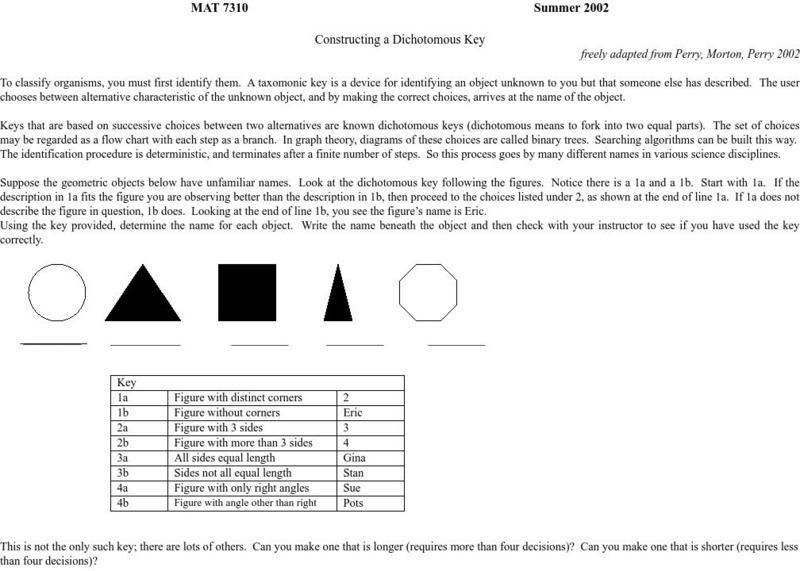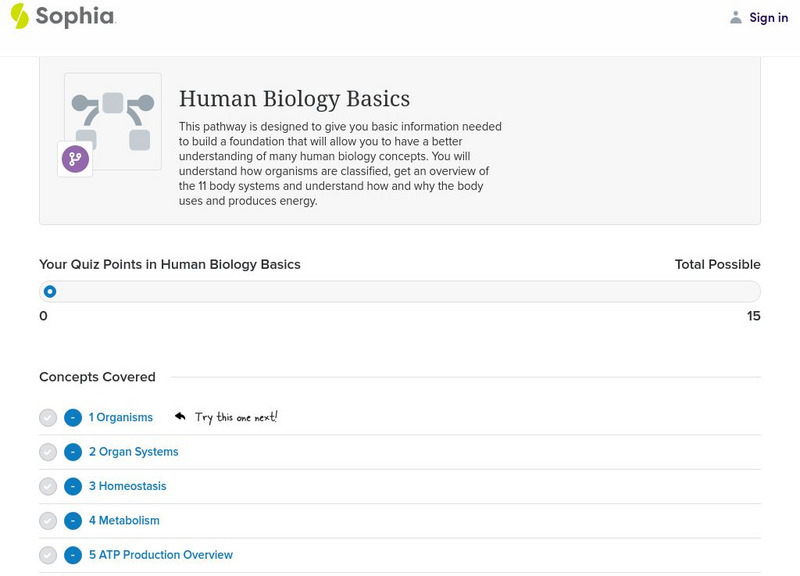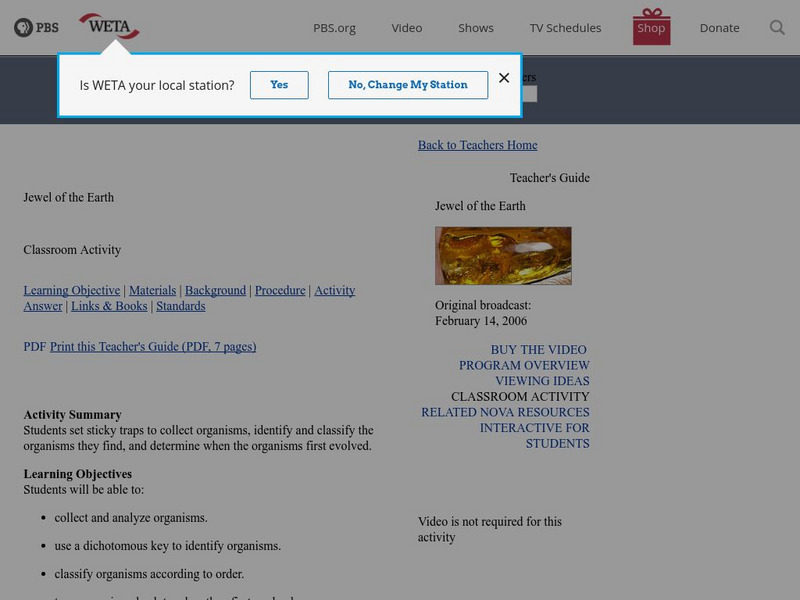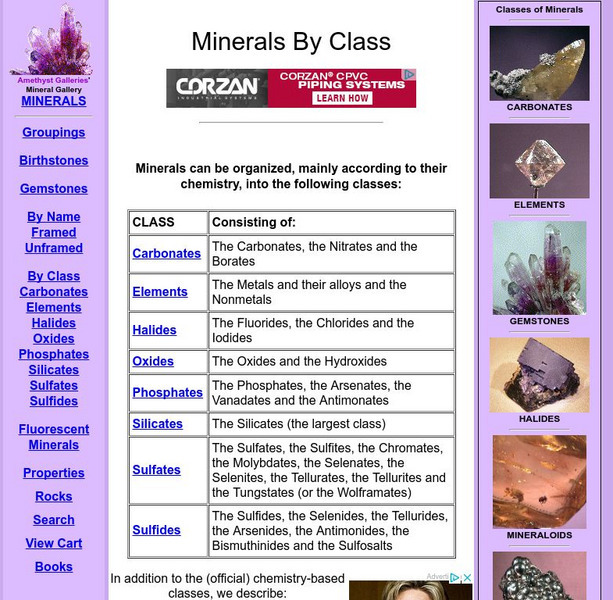Alabama Learning Exchange
Alex: I Know What I Am, but What Are You?
During this lesson students will develop an understanding of how to classify living things and what creates the distinction among them. They will learn to classify living things by effects, environment, and activity.
Other
My Science Box: Is It Alive?
A lesson plan that introduces students to the concept of classifying objects as either living or non-living. From this lesson, students begin to think about the necessary characteristics of life.
CPALMS
Florida State University Cpalms: Florida Students: Diagramming Diversity Ii
Expand understanding of classification with this tutorial designed to help you learn how living organisms are classified according to their evolutionary history.
Discovery Education
Discovery Education: Animal Classification
Use this lesson to help students understand the reasons for classifications and ways that different species are separated.
Other
Siemens Science Day: Life Science: The Key to It All
In this hands-on science activity, students will create their own unique creatures as well as dichotomous keys so that classmates can identify the creature.
ClassFlow
Class Flow: Animal Classification
[Free Registration/Login Required] Students will classify organisms into groups and relate how they determined the groups with how and why scientists use classification. They will also demonstrate how animals are sorted into groups...
PBS
Pbs Teachers: Volcanoes of the Deep
Discuss how individual organisms and groups of organisms interact with each other, and research and classify symbiotic relationships between individual organisms of different species.
Other
Contract Magazine
Magazine for commercial interior design and architecture. Provides pages of projects, articles about the business of design, links to organizations and publications.
Other
Villanova University: Constructing a Dichotomous Key
This exercise provides information on how to construct a dichotomous key using geometrical shapes. Another exercise shows how a key can be constructed based on traits in a classroom group.
Rice University
Rice University: The Hand Squeeze
Students will enjoy this data collection and class analysis experiment involving the time it takes for a hand squeeze to travel around a circle of people. From organizing the activity to collecting the data to making a table and graphing...
Texas Education Agency
Texas Gateway: Taxonomy: Major Groups
Do you know that organisms are classified into different categories? This tutorial will show you how organisms are classified into three different groups called domains. Then see how those domains are broken down into kingdoms!
University of California
Ucmp: The World's Biomes
The University of California Museum of Paleontology hosts this site devoted to the study of the earth's biomes, which are the world's major communities, classified according to the predominant vegetation and adaptations of organisms to...
BiologyWise
Biology Wise: Classification of Bacteria
Explains how bacteria are classified by gram staining for medical purposes, and how they are classified by scientists based on Bergy's Manual of Systematic Classification. Also presents a list of hundreds of bacteria organized into their...
Sheppard Software
Sheppard Software: Parts of the Food Chain: Producers, Consumers, Decomposers
Learn how scientists classify different types of organisms in an ecosystem or in a food chain by their role and function as either a producer, a consumer, or a decomposer. Then play a game that tests your understanding of these important...
University of Wisconsin
Geography 101: Soil Characteristics
By the end of this unit you should be able to: list the seven characteristics used to describe soils, to distinguish one soil from another soil, and to distinguish one soil layer from another soil layer; explain the impact of soil...
Sophia Learning
Sophia: Human Biology Basics
A learning module that is "designed to give you basic information needed to build a foundation that will allow you to have a better understanding of many human biology concepts. You will understand how organisms are classified, get an...
BiologyWise
Biology Wise: Different Types of Bacteria
Discusses the different criteria used to classify bacteria and the groups of bacteria within each category. Groups are organized by characteristics such as morphology, shape, cell wall structure, and presence of flagella.
BiologyWise
Biology Wise: List of Bacteria
Describes the structure of bacteria, where bacteria can be found, and how they are classified using gram staining. Includes lists of bacteria organized by gram staining response and whether they have a capsule shape. Also includes a list...
Education.com
Education.com: Sorting Objects by Material
[Free Registration/Login Required] This game challenges kids to sort objects by material. Taking their cues from the Three Little Pigs, preschoolers will sort items made of straw into one backpack, sticks into another, and bricks into a...
Other
Alternative Classifications of Life
The Linnaean system (1758) classified all macroscopic living organisms as either Animals or Plants, based on whether they moved [anima, with a soul] or not. Thus, Fungi were included as plants. With the invention of the microscope and...
PBS
Pbs Teachers: Jewel of the Earth
Collect and analyze organisms and use a dichotomous key to identify and classify the organisms. Research the evolutionary history of organisms.
Wikimedia
Wikipedia: Social Bookmarking
This article introduces the reader to the concept of social bookmarking which organizes sites generally by the use of tags. Social bookmarking sites are an increasingly popular way to locate, classify, rank, and share Internet resources...
Science4Fun
Science4 Fun: Periodic Table
What is the periodic table? Learn how the elements are classified according to their properties and are organized into groups and periods.
Amethyst Galleries
Amethyst Galleries: Mineral Gallery: Minerals by Class
This is a detailed reference list of minerals and mineral classes.




















